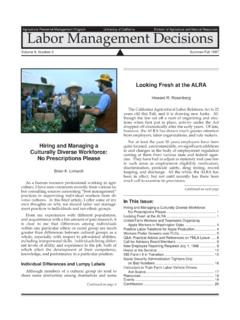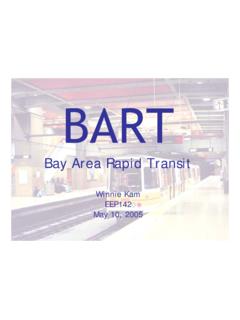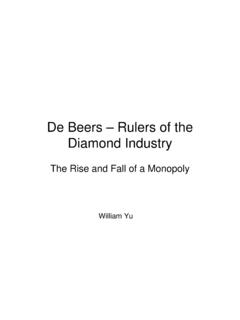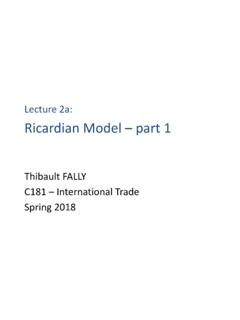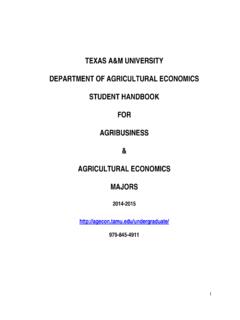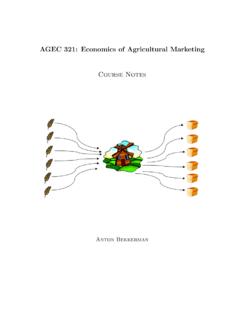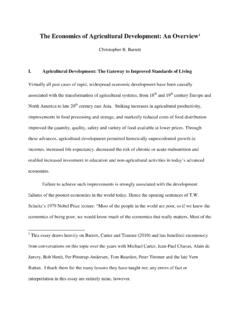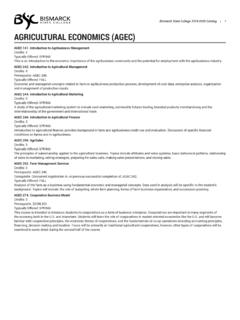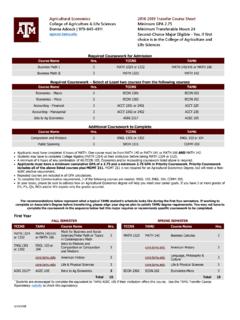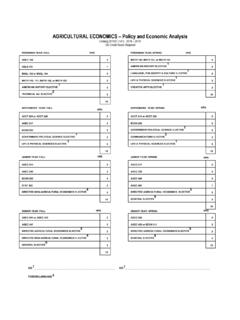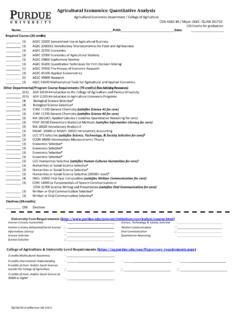Transcription of Rural Development and Rural Policy I. Agricultural ...
1 1 June 1999 Rural Development and Rural Policy1byAlain de Janvry*, Rinku Murgai , and Elisabeth Sadoulet*University of California at Berkeley* and The World Bank I. Agricultural economics and Rural economicsAgricultural economics has been principally concerned with the economics of agriculture as asector. The elementary unit of analysis is the farm. The major fields of analysis are farm production, themarketing of Agricultural commodities and the demand for food, the performance of product and factormarkets, the linkages between agriculture and other sectors of the economy and the rest of the world,sustainability in resource use, and Agricultural and food Policy . Rural economics and the design of Rural policies to achieve Rural Development constitute a broadersubject than Agricultural economics with a spatial as opposed to a sectoral definition. The elementary unitof analysis is the household, with the farm as a typical subset of economic activity.
2 The fields ofapplication of Rural economics include resource allocation by households and their choices of incomestrategies, the emergence and performance of agrarian institutions, income levels achieved by specificcategories of Rural inhabitants, poverty and inequality, income and food security, the satisfaction of basicneeds (in particular access to public goods and services such as health and education), intergenerationalequity, and the broad characterization of the quality of life for Rural households (which includes features suchas individual freedoms, the range of available opportunities and capabilities (Sen, 1985), communityrelations and congeniality, the rule of law and respect of human rights, political rights, etc.). Ruraleconomics requires focusing importantly on the heterogeneity of Rural populations that inhabit a particularregion since the determinants of welfare are highly varied.
3 For Rural Development , who produces inagriculture matters for efficiency and welfare, for instance small holders as opposed to large commercialfarmers. Where Agricultural production takes place also matters, for instance in better endowed versusmarginal areas. What non-farm sources of income exist in particular regions and which particular classes ofhouseholds are able to participate to those is important for the determination of household incomes. Howhouseholds aggregate in communities and the level of social capital they contain explains the efficiency ofrural institutions and the ability to cooperate in the provision of public goods and the appropriation ofcommon pool resources. And how sizable are the local linkages between farm and non-farm activities,particularly the multiplier effects created by the expenditure of farm incomes, matters for the creation ofnon-farm incomes that supplement for farm households the incomes derived from agriculture and createemployment opportunities for Rural non-farm spite of the importance of the subject, Rural economists have been a rare breed in the economicprofession compared to Agricultural economists.
4 As a result, analyses of Rural societies have morefrequently been done by sociologists, anthropologists, and geographers than by Rural economists, and byextension agents rather than research faculties. In spite of the many insights derived from these studies, thescarcity of Rural economists creates two important voids. One is a deficit of rigorous economic theoriesexplaining the determinants of behavior among households and communities and the logic of agrarianinstitutions. This is detrimental to conduct solid empirical analyses of these subjects. The other isinsufficient Policy purpose in the research conducted since these other social sciences tend to be moreinterested in positive than in normative analysis. Systematic primary data have also been incredibly scarce,particularly long series panel data that are needed to analyze the successive rounds of response to changewhile controlling for many non-observables.
5 Interdisciplinary approaches using rapid and participatory ruralappraisal techniques (Chambers, 1993) are extremely powerful to reveal the perceptions of actors and toidentify new hypotheses, but are a weak basis for the formulation of economic Policy due to lack ofrepresentativity and of quantification. As a result, Rural Policy has all too often been based on highlyincomplete understandings of the material and behavioral determinants of household, community, andinstitutional responses. Heroic controversies about the determinants of household behavior, for instancebetween formalists and substantivists in peasant anthropology (LeClair and Schneider, 1968), have been 1 Paper prepared for the forthcoming Handbook of Agricultural 1999largely based on misinterpretations of the structural context within which households exercise their choices(see de Janvry, Fafchamps, and Sadoulet, 1991).
6 The highly complex trade-offs between themultidimensional objectives of Rural Policy remain poorly measured. And prescriptions for ruraldevelopment have all too often followed simplistic bandwagon ideas where the presumed silver bullet forsuccess has failed to recognize the heterogeneity of households and communities and the complexity ofdeterminants of behavior, creating waves of enthusiasm and agriculture remains an important source of dynamism for Rural areas, even when the sectordirectly generates only a small fraction of regional income, an Agricultural Policy that stimulates investmentand productivity gains is a necessary, if not a sufficient, condition for Rural Development . In most LDCs(less developed countries) Agricultural Policy , either made at the macro level via the exchange rate and theintersectoral terms of trade for agriculture, or at the sectoral level via commodity-specific tradeinterventions, taxes, and subsidies, has played against Rural Policy (Lipton, 1977; Krueger, Schiff, andVald s, 1988).
7 By discriminating against agriculture, Policy has created disincentives to invest inagriculture and undervalued the conservation of natural resources. Hence, not only has Agricultural policybeen made ignoring Rural Policy , but it has often been its worst enemy, creating widespread suspicionamong Rural Development advocates about the ability of economists to contribute useful prescriptions forthe improvement of Rural welfare (Altieri, 1989; Chambers, 1993; Norgaard, 1994).Very important changes have, however, occurred in recent years, with major advances in ruraleconomics and in the design of new approaches to Rural Development . From the angle of theory, thesechanges derive from progress in household and community economics, the theory of agrarian institutions,and understanding the endogenous determinants of regional growth. From the angle of empiricism,extensive data bases have allowed to uncover regularities and test new ideas for Rural Development as couldnever have been done before.
8 And from the angle of the practice of Rural Development , a new economic ,institutional, and political context that emerged largely in the 1990s has opened the possibility ofexperimenting with novel approaches to Rural Development , some of which show definite promise. It is theobjective of this chapter to map out these changes, analyze the nature of their contributions to ruraldevelopment, and identify important gaps that remain to be filled. II. Why the need for a Rural Policy ? The less developed countriesIn the LDCs, Rural underdevelopment remains a fundamental determinant of overallunderdevelopment. Nearly three fourths of the billion world poor who subsist on less than one dollar aday live in Rural areas (World Bank, 1997). Three fourths of the world 800 million underfed also live inrural areas. In spite of rapid urbanization, a majority of the world poor and underfed will remain in ruralareas for the next several decades.
9 And levels of poverty are typically much deeper in Rural areas. In 19countries of Latin America with data, for instance, the poverty headcount ratio was 55% in the Rural sectorcompared to 34% in the urban sector in 1994 (ECLAC, 1997). And the incidence of extreme poverty was33% in the Rural sector compared to only 12% in the urban sector. With typical public underinvestment inrural areas combined with higher costs of delivery, levels of basic needs for amenities such as health,education, potable water, and sanitation are also lower than in the urban areas. This situation of chronicpoverty in Rural areas has often led to backlashes against the economic models pursued by governments atthe national level. In Peru, Colombia, Guatemala, and Mexico, as well as many African nations, ruralviolence has, on repeated occasions, been a source of political destabilization, with heavy poverty can also create serious negative externalities on a country s metropolitan migratory flows crowd out urban residents on non-farm labor markets and displace Rural poverty tothe urban slums, adding to urban welfare budgets.
10 And environmental abuse associated with the pressuresof Rural poverty contributes to national and global externalities under the form of siltage, exhaustion ofunderground water reserves, desertification, deforestation, loss of biodiversity, and climate many countries, small holders are a fundamental source of Agricultural supply. In this case, theproblem of Rural Development becomes confounded with that of Agricultural Development . This is3 June 1999particularly true in Sub-Saharan Africa where most of the land is cultivated by small holders. Withpopulation expected to triple by 2025 and low tradability of many staples, food security is at risk. To faceup to this challenge, it is thus essential to raise the productivity and efficiency of Rural households in usingresources and to enhance their ability to protect the environment. In other countries, particularly LatinAmerica, even though the national food security problem can be addressed through trade or throughproduction in a large sector of commercial farms (making the problem one of Agricultural as opposed torural Policy ), agriculture remains a major source of income for many Rural poor households.

